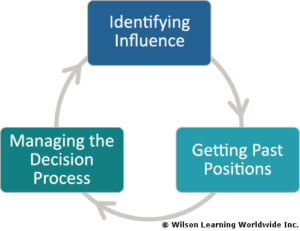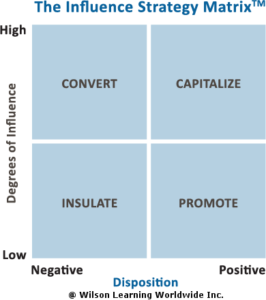Nothing derails a sale faster than multiple decision-makers! And, while more than 85 percent of opportunities involve multiple decision-makers, most organizations do a poor job of preparing their salespeople to sell to decision-making teams.
This poor preparation causes a significant number of hits to the seller’s top and bottom line:
- Decisions take longer and become more expensive.
- There is an increase in the number of “no decisions.”
- Profit margins are squeezed in efforts to satisfy everyone.
- Implementation is delayed.
Maximizing Results with Multiple Decision-Makers
When sales organizations coach their sales teams in the concepts and skills related to managing multiple decision-makers, sales effectiveness improves.
We have found there are three keys to selling effectively to multiple decision-makers, as shown in the following framework.
Taken together, these three skills give the selling organization and the buying organization an improved chance to reach a buying decision that produces the maximum business value to both organizations.
Identifying Influence: The Influence Map

Guiding multiple decision-makers begins by identifying how decision-makers align within the Influence Map.
Many salespeople take the perspective that an individual’s title is all they need to know—but the Influence Map is more complex than that. The Influence Map is determined by two critical elements: Influence and Disposition.
Influence can take many forms—formal, informal, level of expertise, credibility, etc. If salespeople focus exclusively on formal influence (the person with the biggest title wins), they will likely draw a poor Influence Map.
 It is also critical to consider a decision-maker’s Disposition—their favorable or unfavorable view of you, your company, and your solution. Two buyers with high levels of influence, one with a favorable disposition, the other with an unfavorable disposition, have to be regarded differently if you are going to win more sales.
It is also critical to consider a decision-maker’s Disposition—their favorable or unfavorable view of you, your company, and your solution. Two buyers with high levels of influence, one with a favorable disposition, the other with an unfavorable disposition, have to be regarded differently if you are going to win more sales.
To learn how to deal with multiple decision-makers, we ask salespeople to create a simple Influence Map that shows where each decision-maker stands on Influence (Low to High) and Disposition (Negative to Positive).
Salespeople should do this for every sales opportunity. One Influence Map does not encompass an entire buying organization; instead, each decision requires its own Influence Map. Why? A person with high influence for one purchase may be low influence for another.


 What the salesperson found out was the CFO was concerned about ROI; the projections for the number of new customers from social media marketing were not high enough to justify the level of investment requested by the VP of Sales and the Marketing Director.
What the salesperson found out was the CFO was concerned about ROI; the projections for the number of new customers from social media marketing were not high enough to justify the level of investment requested by the VP of Sales and the Marketing Director.